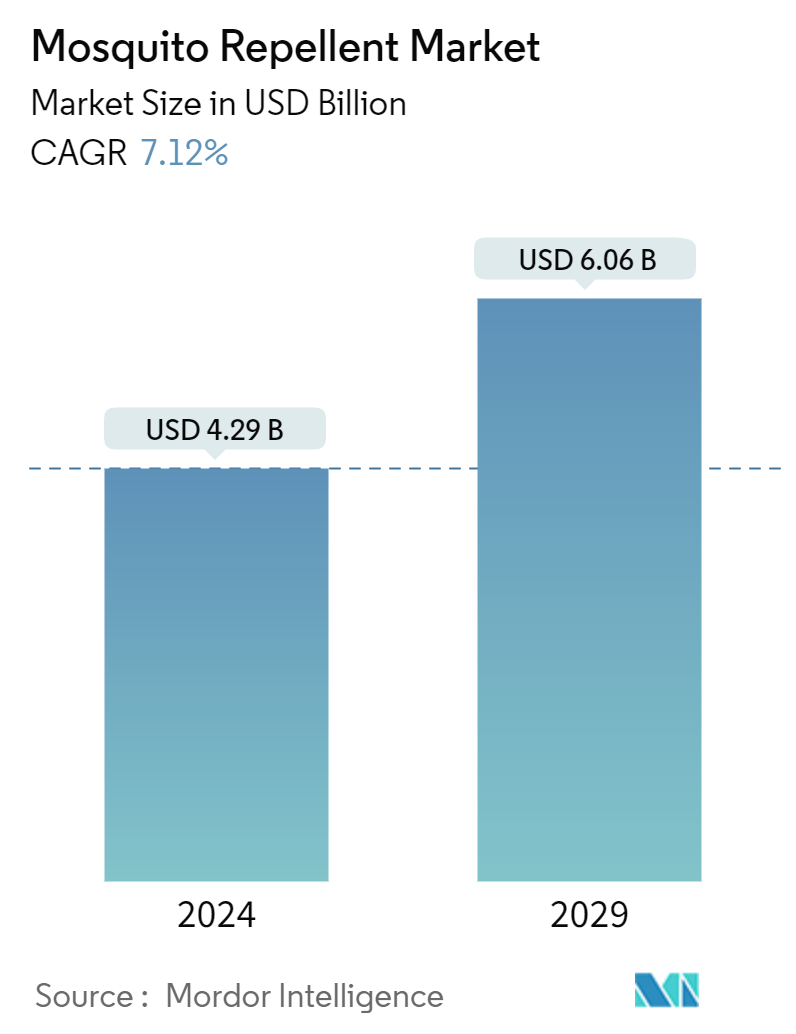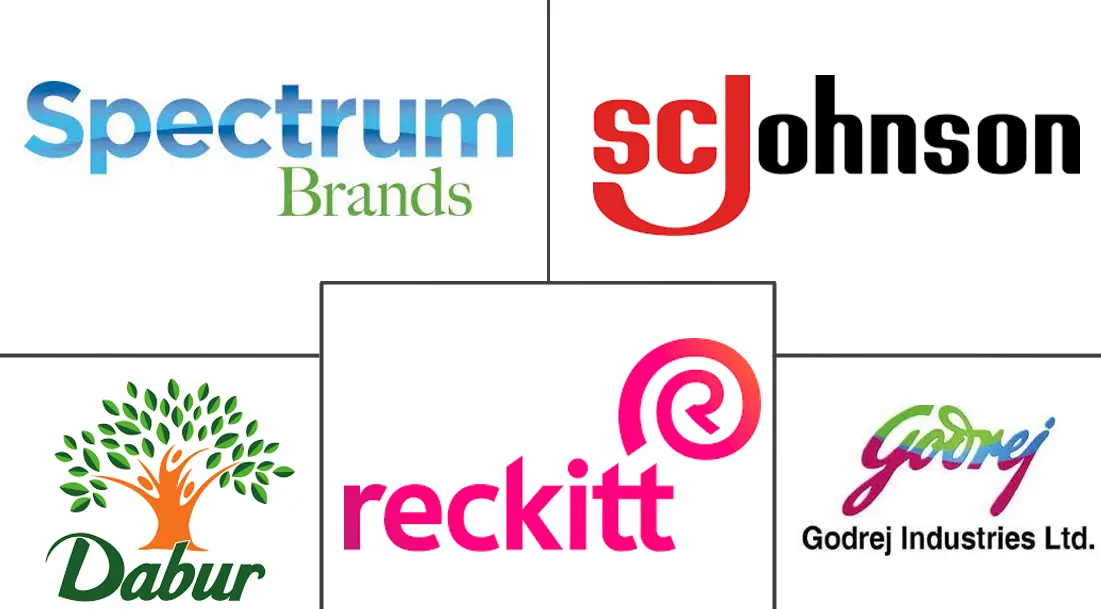Market Size of Mosquito Repellent Industry

| Study Period | 2019 - 2029 |
| Market Size (2024) | USD 4.29 Billion |
| Market Size (2029) | USD 6.06 Billion |
| CAGR (2024 - 2029) | 7.12 % |
| Fastest Growing Market | Asia Pacific |
| Largest Market | Asia Pacific |
Major Players
*Disclaimer: Major Players sorted in no particular order |
Mosquito Repellent Market Analysis
The Mosquito Repellent Market size is estimated at USD 4.29 billion in 2024, and is expected to reach USD 6.06 billion by 2029, growing at a CAGR of 7.12% during the forecast period (2024-2029).
The increase in consumer awareness regarding mosquito-borne diseases and rising demand for maintenance of health and hygiene is propelling the growth of mosquito repellents in the global market. In addition to this, the incidences of vector-borne diseases such as dengue, malaria, chikungunya, Japanese encephalitis, and lymphatic filariasis are on the rise. These diseases pose significant public health concerns globally, with most of them being prevalent during the monsoon season. For instance, in October 2023, Bangladesh witnessed the worst dengue outbreak on record, with rising temperatures due to climate change driving the ongoing spread in both rural and urban areas. The official statistics from the Bangladesh Directorate General of Health Services claimed that as of January 2023, 1,017 people had died across the country, including more than 100 children, with infections rising to over 208,000. Such mosquito diseases not only affect humans, but they also transmit several diseases and parasites to dogs, such as dog heartworm, West Nile virus (WNV), and Eastern equine encephalitis (EEE).
Moreover, companies operating in the mosquito repellent market are working closely with regional governments and universities worldwide to run several awareness campaigns to educate the public about ways to avoid insects and, consequently, prevent diseases. Additionally, advertising campaigns play an important role in promoting consumer awareness and product education. For instance, in October 2021, Dabur India Ltd launched its mega initiative, the #MakingIndiaDengueFree campaign, to promote its mosquito repellent brand, Odomos. Such campaigns, coupled with the growing trend of natural and plant-based repellents and products with long-lasting effectiveness, are some factors supporting the market’s growth across the globe. Moreover, eco-friendly and non-toxic formulations are gaining popularity in the market. This, in turn, encourages manufacturers to launch new products. For instance, in 2022, S.C. Johnson launched STEM, a new lineup of mosquito repellent in spray and wipe forms. As per the company’s claim, the STEM mosquito repellent is formulated using plant-active ingredients such as lemongrass, mint, and rosemary oil to provide an effective solution.
Mosquito Repellent Industry Segmentation
Mosquito repellents are agents used to protect the body from mosquito bites that can cause skin irritation and many other unfavorable effects. The market is segmented based on product type, ingredient type, distribution channel, and geography. Based on product type, the market is segmented into liquid vaporizers, coils, sprays/aerosols, creams, lotions, and roll-ons, and other product types. Based on ingredient type, the market is segmented into natural mosquito repellent and conventional mosquito repellent. Based on distribution channels, the market is segmented into supermarkets/hypermarkets, convenience/grocery stores, online retailers, and other distribution channels. The study also captures the market across various economies, including North America, Europe, Asia-Pacific, South America, and the Middle East and Africa. The market sizing has been done in value terms in USD for all the abovementioned segments.
| Product Type | |
| Liquid Vaporizers | |
| Coils | |
| Sprays/Aerosols | |
| Creams, Lotions, and Roll-ons | |
| Other Product Types |
| Ingredient Type | |
| Natural Mosquito Repellent | |
| Conventional Mosquito Repellent |
| Distribution Channel | |
| Supermarkets/Hypermarkets | |
| Convenience/Grocery Stores | |
| Online Retail Stores | |
| Other Distribution Channels |
| Geography | |||||||||
| |||||||||
| |||||||||
| |||||||||
| |||||||||
|
Mosquito Repellent Market Size Summary
The mosquito repellent market is experiencing significant growth, driven by increasing consumer awareness of mosquito-borne diseases and a rising demand for health and hygiene maintenance. The prevalence of vector-borne diseases such as dengue, malaria, and chikungunya, particularly during the monsoon season, has heightened public health concerns globally. This has led to a surge in demand for mosquito repellents as a preventive measure. Companies in the industry are actively collaborating with governments and educational institutions to run awareness campaigns, while also leveraging advertising to educate consumers about the importance of using repellents. The market is also witnessing a shift towards natural and plant-based products, with eco-friendly and non-toxic formulations gaining popularity. This trend is encouraging manufacturers to innovate and launch new products, such as S.C. Johnson's STEM line, which uses plant-active ingredients for effective mosquito protection.
The Asia-Pacific region holds the largest market share, with substantial growth potential due to the high incidence of mosquito-borne diseases and supportive government initiatives. Countries like China and India are facing challenges from these diseases, prompting increased demand for repellents. The market is characterized by a competitive landscape, with major players like Godrej Consumer Products Ltd, S.C. Johnson & Son, and Dabur India Ltd engaging in product launches, expansions, and strategic partnerships to strengthen their market presence. The introduction of products catering to both high-end and low-end economic groups, along with social media campaigns, is helping these companies capture a broader consumer base. The rise in outdoor activities and the adoption of repellents with pleasant fragrances further contribute to the market's growth, as consumers seek effective and enjoyable solutions for mosquito protection.
Mosquito Repellent Market Size - Table of Contents
-
1. MARKET DYNAMICS
-
1.1 Drivers
-
1.1.1 Rising Incidences of Vector-borne Disease Fueling Market Growth
-
1.1.2 Advertisements and Promotional Campaigns Supporting Demand
-
-
1.2 Restraints
-
1.2.1 Mosquito Repellents: Silent Toxicant to the Environment and Humans
-
-
1.3 Porter's Five Forces Analysis
-
1.3.1 Threat of New Entrants
-
1.3.2 Bargaining Power of Buyers/Consumers
-
1.3.3 Bargaining Power of Suppliers
-
1.3.4 Threat of Substitute Products
-
1.3.5 Intensity of Competitive Rivalry
-
-
-
2. MARKET SEGMENTATION
-
2.1 Product Type
-
2.1.1 Liquid Vaporizers
-
2.1.2 Coils
-
2.1.3 Sprays/Aerosols
-
2.1.4 Creams, Lotions, and Roll-ons
-
2.1.5 Other Product Types
-
-
2.2 Ingredient Type
-
2.2.1 Natural Mosquito Repellent
-
2.2.2 Conventional Mosquito Repellent
-
-
2.3 Distribution Channel
-
2.3.1 Supermarkets/Hypermarkets
-
2.3.2 Convenience/Grocery Stores
-
2.3.3 Online Retail Stores
-
2.3.4 Other Distribution Channels
-
-
2.4 Geography
-
2.4.1 North America
-
2.4.1.1 United States
-
2.4.1.2 Canada
-
2.4.1.3 Mexico
-
2.4.1.4 Rest of North America
-
-
2.4.2 Europe
-
2.4.2.1 United Kingdom
-
2.4.2.2 Germany
-
2.4.2.3 Spain
-
2.4.2.4 France
-
2.4.2.5 Italy
-
2.4.2.6 Russia
-
2.4.2.7 Rest of Europe
-
-
2.4.3 Asia-Pacific
-
2.4.3.1 China
-
2.4.3.2 Japan
-
2.4.3.3 India
-
2.4.3.4 Australia
-
2.4.3.5 Rest of Asia-Pacific
-
-
2.4.4 South America
-
2.4.4.1 Brazil
-
2.4.4.2 Argentina
-
2.4.4.3 Rest of South America
-
-
2.4.5 Middle East and Africa
-
2.4.5.1 South Africa
-
2.4.5.2 Saudi Arabia
-
2.4.5.3 Rest of Middle East and Africa
-
-
-
Mosquito Repellent Market Size FAQs
How big is the Mosquito Repellent Market?
The Mosquito Repellent Market size is expected to reach USD 4.29 billion in 2024 and grow at a CAGR of 7.12% to reach USD 6.06 billion by 2029.
What is the current Mosquito Repellent Market size?
In 2024, the Mosquito Repellent Market size is expected to reach USD 4.29 billion.

